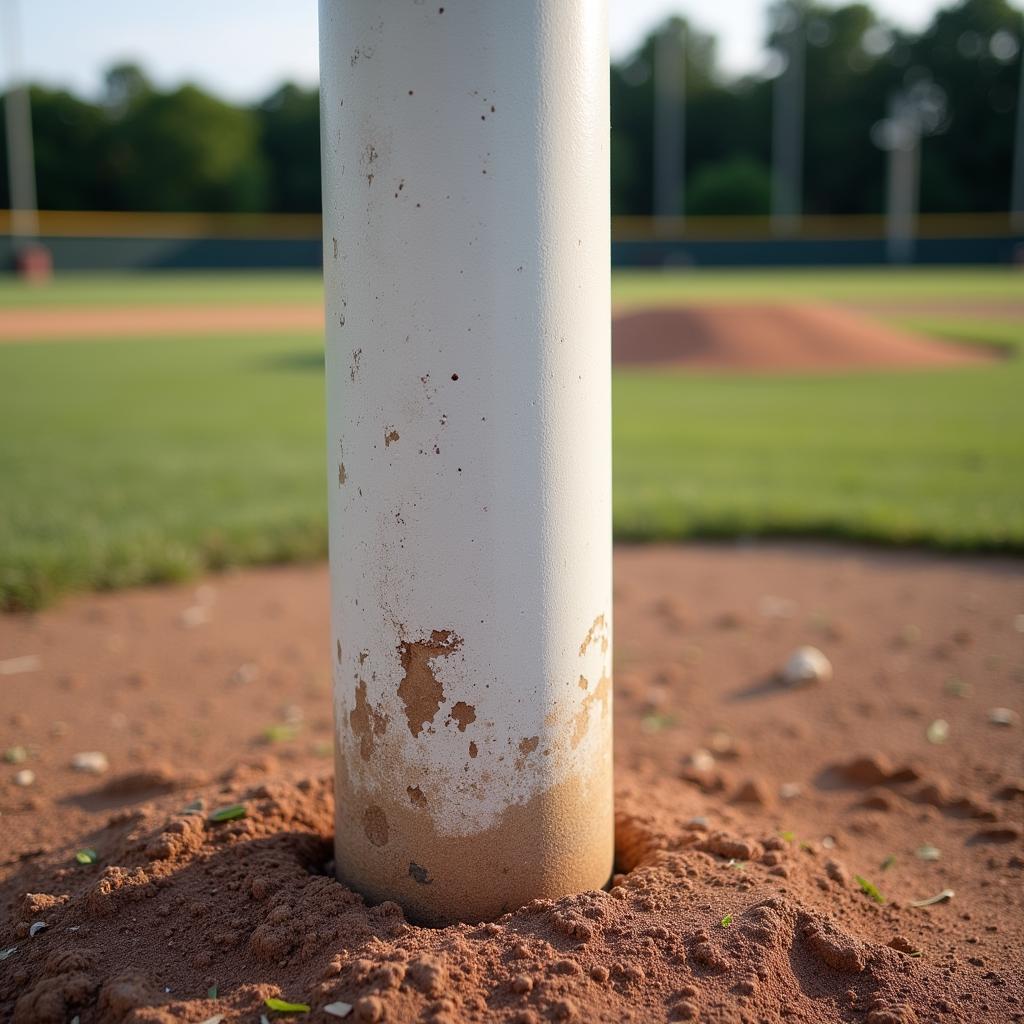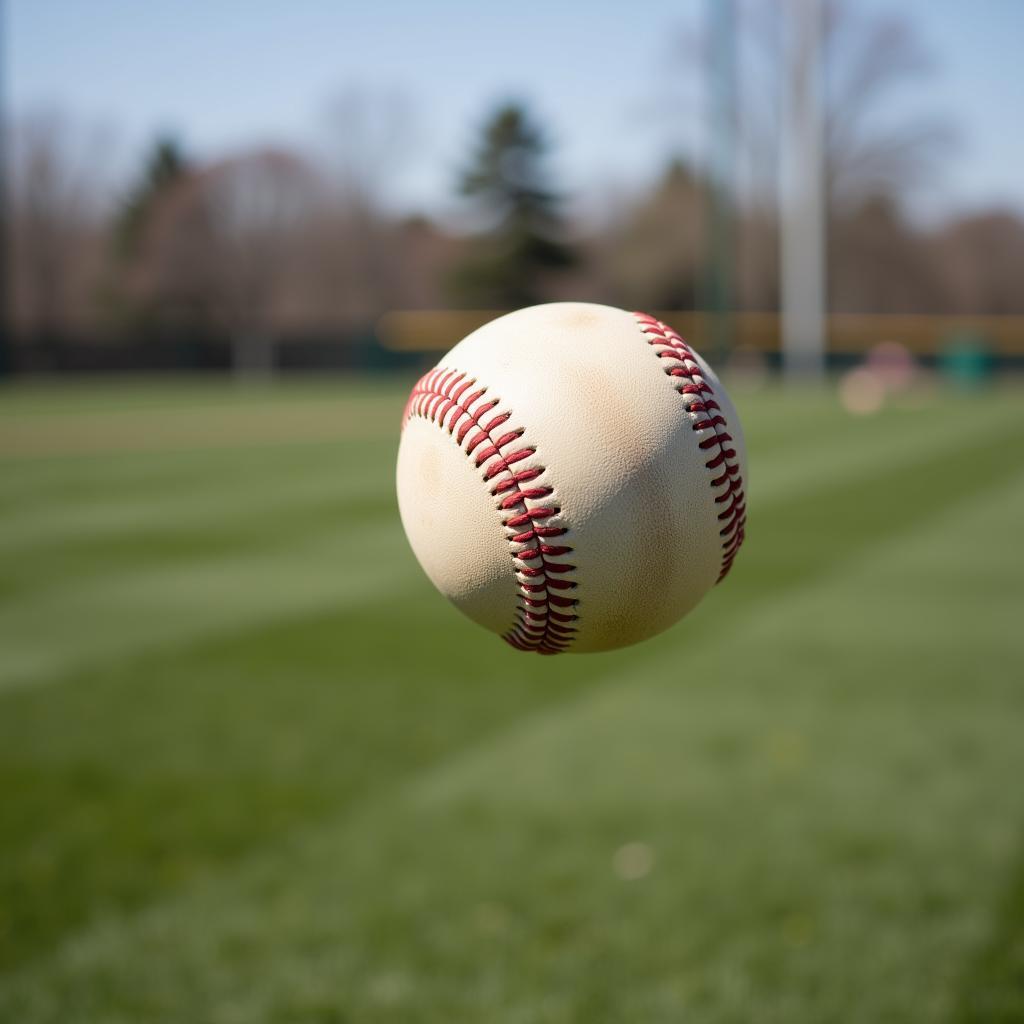Decoding the Baseball Field Foul Pole
November 19, 2024The Baseball Field Foul Pole, a seemingly simple structure, holds a significant role in the game of baseball. It’s the ultimate arbiter of fair and foul balls, instantly deciding the fate of a soaring hit. But there’s more to these poles than meets the eye. Let’s dive into the details of these often overlooked yet crucial elements of the baseball diamond.
 Close-up of a baseball field foul pole showing its construction and markings.
Close-up of a baseball field foul pole showing its construction and markings.
What is a Baseball Field Foul Pole?
What exactly is a baseball field foul pole, and why is it so important? These poles, also known as foul markers, are vertical structures located at the intersection of the foul lines and the outfield fence. They define the boundaries of fair territory and play a crucial role in determining whether a batted ball is fair or foul. A ball that hits the foul pole in the air is considered a home run, one of the most exciting plays in baseball. Conversely, a ball that passes over the foul pole in flight is deemed a foul ball, even if it lands in fair territory.
Imagine a tense moment: bases loaded, bottom of the ninth, two outs. The batter swings, and the ball sails high towards the left field foul pole. Everyone holds their breath. Does it hit the pole? Does it curve foul? The foul pole provides the definitive answer, instantly transforming the game’s momentum.
The Importance of Foul Poles in Baseball
Why are these seemingly simple poles so vital to the game? Because without them, determining fair and foul balls in the air would be left to the subjective judgment of the umpires, potentially leading to disputes and inconsistencies. The foul poles provide a clear, objective standard, ensuring fair play and contributing to the integrity of the game. They remove ambiguity and provide a visual marker for both players and spectators.
Foul Poles and Home Runs
The foul pole’s most dramatic function is its role in determining home runs. That satisfying clang of a baseball hitting the foul pole signals an automatic home run, regardless of where the ball lands afterwards. This creates a dramatic moment, often changing the course of a game in an instant.
 A baseball flying through the air in fair territory just inside the foul pole.
A baseball flying through the air in fair territory just inside the foul pole.
Foul Poles and Fair/Foul Calls
Beyond home runs, the foul poles help umpires make accurate fair/foul calls on balls hit high in the air. The poles act as a vertical extension of the foul line, helping to define the boundary between fair and foul territory in the outfield.
ball hits bat in fair territory
“The foul poles are essential for maintaining consistency in calls,” says fictional umpire, Albert “Al” Strikezone. “They provide a fixed point of reference, eliminating guesswork and ensuring fair play.”
Different Types of Foul Poles
While the function of foul poles remains consistent, their appearance can vary. Some are simple, unadorned poles, while others are more elaborate, sometimes featuring padding or netting. Some older ballparks even have unique, historically significant foul poles. This variety adds to the unique character of each baseball field.
Foul Pole Materials and Construction
Foul poles are typically constructed from metal, often steel or aluminum, to withstand the impact of baseballs and the elements. They are securely anchored to the ground to ensure stability.
“A sturdy foul pole is crucial for player safety,” adds fictional groundskeeper, Ray Diamond. “You don’t want that thing coming down during a game!”
Conclusion
The baseball field foul pole, often overlooked, plays a vital role in the game. It defines fair territory, determines home runs, and helps umpires make accurate calls. From the little league field to the major leagues, these unassuming structures ensure fair play and contribute to the excitement and integrity of baseball. Understanding their importance adds another layer of appreciation for this beloved sport.
FAQ:
- What happens if the ball hits the foul pole on the ground? (It’s a foul ball).
- Are foul poles always the same height? (No, they can vary depending on the ballpark).
- What if a foul pole breaks during a game? (The game is typically delayed while it’s repaired or replaced).
- Can a ball hit the foul pole and bounce back into fair territory? (Yes, and it would still be a home run).
- Are there any rules about the color of foul poles? (No specific rules, but they’re typically yellow or white for visibility).
- What happens if a player runs into the foul pole? (It’s considered an out of play area, and the play is dead.)
- Can a foul pole be used as a base? (No, it is not considered a base.)
For further information on baseball field dimensions and rules, check out our articles on cbc baseball field and ball hits bat in fair territory.
For support, contact Phone Number: 0963418788, Email: [email protected] Or visit us at: 2M4H+PMH, Phường Nghĩa Thành, Gia Nghĩa, Đắk Nông, Việt Nam. We have a 24/7 customer service team.